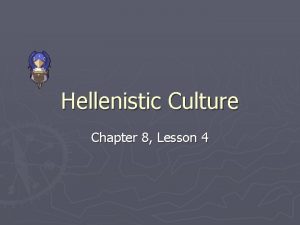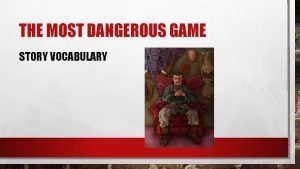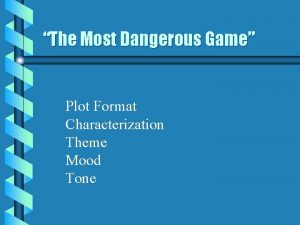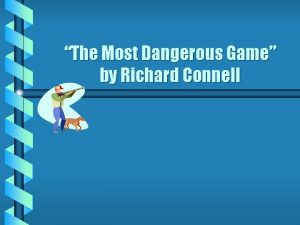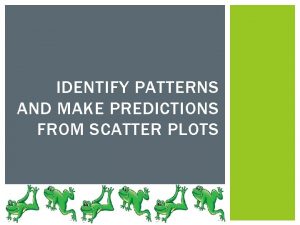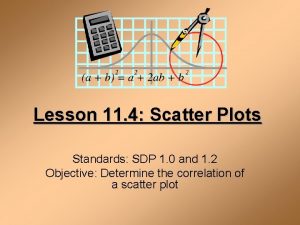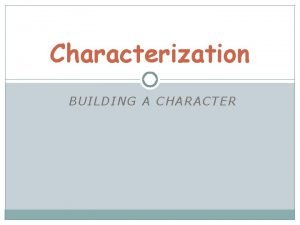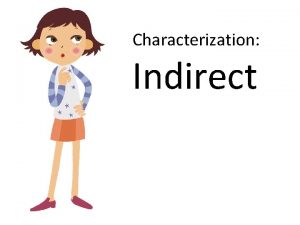Sitcoms Characterization In situation comedies most plots are













- Slides: 13

Sitcoms

Characterization • In situation comedies most plots are short lived. They end in one or two episodes. Therefore, to establish an audience sitcoms rely on characters that people find interesting or relatable

Characterization • Main Characters • Supporting Characters/Stock Characters

Main Characters • The main character in a sitcom will often have very specific traits. It is how those traits are expressed week to week that keeps the audience interested. • They may already know that Jerry from Seinfeld is a neat freak and finds reasons to break up with women, but showing the methods the Seinfeld writers use to establish these facts and express them week to week is how we are able to connect with the character.

Stock Characters • Stock characters can also be a useful tool for to identify established character types. • George in Seinfeld is short, balding, middleaged, stocky and lonely. This tells the audience he will be a loser before it is established that he is always complaining and rarely succeeds.

Common Stock Characters • • The Naive Fool: Misunderstands situations and creates conflict for the show. – Cory on Boy Meets World – Carlton on Fresh Prince of Bel Air – Kelso on That 70's Show The Sage: A character with a quirk or outsider experience. This could be someone who is older in the cast, has advanced intellect, or someone who doesn't seem to belong with the rest of the characters. – Fonz in Happy Days – Lisa in The Simpsons – Frasier on Cheers The Comic Relief: Usually has eccentricities and personality traits that give them strange reactions to the conflict. Can sometimes be the protagonist. : – Urkel in Family Matters – Kramer in Seinfeld The Nosy Neighbor: Always around to see what kind of mischief the main characters are getting into. – Mr. Roper in Three's Company – Flanders in The Simpsons Wacky Wife/Straitlaced Husband: This husband/wife team usually sees the female getting into trouble, while the husband has to bail her out. – Lucy/Ricky in I Love Lucy – Samantha/Darin in Bewitched The Lovable Loser: Always in trouble. Usually in the wrong place at the wrong time. The audience must feel for this character or the show will not work. – Homer in The Simpsons The Cutesy Moppet: Always around to give the audience a heartfelt moment. – Michelle in Full House – Morgan in Boy Meets World

Narrative • Studying the narrative of a television sitcom focuses attention on the elements that constitute a good story. • Sitcoms are a highly accessible venue for exploring the elements of a narrative. One is able to look at many different types of plots within one episode and the chronological order of their presentation, while practicing the use of narrative models to explain each plot's development

Freytag's Triangle

3 Act Structure • A key element of the TV sitcom, no matter if its narrative structure is episodic or serial, is the three act structure. What the three act structure consists off is a kind of guide, which serves to construct stories around. It follows what seems to be a logical and natural progression of events starting by – Act I: the introduction of the main characters and the dramatic problem. – Act II: a series of complications that arise for our hero as he tries to take over the problem. – Act III: a climactic point where the hero finally overcomes the obstacles and reaches his goal and everything is resolved.

3 Act Structure • In TV sitcoms there is a pause in between each act, due to the fact that the shows have to cut to commercial breaks in order to advertise their sponsors. Along with this obligatory pauses in the narrative that threaten the flow and logical progression of the story we discussed before, TV programmers and writers employ a simple technique in order to maintain an interest in the story after all the breaks. What they do is they insert commercial breaks at turning points or also known as plot points. These are the transitions from act to act.

3 Act Structure • In the end the commercial breaks in the sitcom came at the turning points leaving the viewer hanging with promises that everything will be answered and resolved after the commercial break and it did. So you see TV sitcoms keep the three act structure but TV writers have to raise the stakes and design their stories around cliffhangers to ensure that the audience stays tuned after the commercial breaks.

Narrative Plot • A-plot, is that part of your script which fuels the actions of the main characters in the script, and generally pushes the story along, as in: “Oh no, the city is under attack—thank goodness the Power Rangers are here to fight the monster and save us all!” • B-plot is that part of your script which expresses the emotional entanglements and problems of your main characters tangentially to the doomsday scenario that is unfolding, as in: Carrie Bradshaw’s life may be in ruins, but wait—who in the world is that dreamboat? Let me date him and report back to my friends!

Sitcoms • Sitcoms are a simple means of exploring narrative. The conciseness of each episode and clear, set pattern of events allows students to easily notice the elements that constitute a story and its plot. • In addition, learners practice using narrative models to extrapolate the relationship that exists between events within the story line. Such skill development, aids in the active reading of other visual and written texts and their ability to construct meaning.
 Mikael ferm
Mikael ferm Shakespeare's comedies tend to end with a
Shakespeare's comedies tend to end with a A writer of comedies during the hellenistic era
A writer of comedies during the hellenistic era What is direct characterization?
What is direct characterization? Direct and indirect characterization
Direct and indirect characterization Most dangerous game theme
Most dangerous game theme The most dangerous game vocabulary
The most dangerous game vocabulary The most dangerous game tone
The most dangerous game tone Indirect characterization in the most dangerous game
Indirect characterization in the most dangerous game Make a prediction
Make a prediction Scatter plots and data student handout 4
Scatter plots and data student handout 4 Draw a correlation
Draw a correlation Box plot worksheet
Box plot worksheet Make a prediction
Make a prediction


